Related Research Articles
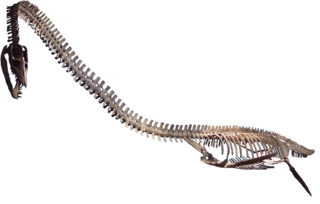
Elasmosaurus (;) is a genus of plesiosaur that lived in North America during the Campanian stage of the Late Cretaceous period, about 80.5 million years ago. The first specimen was discovered in 1867 near Fort Wallace, Kansas, US, and was sent to the American paleontologist Edward Drinker Cope, who named it E. platyurus in 1868. The generic name means "thin-plate reptile", and the specific name means "flat-tailed". Cope originally reconstructed the skeleton of Elasmosaurus with the skull at the end of the tail, an error which was made light of by the paleontologist Othniel Charles Marsh, and became part of their "Bone Wars" rivalry. Only one incomplete Elasmosaurus skeleton is definitely known, consisting of a fragmentary skull, the spine, and the pectoral and pelvic girdles, and a single species is recognized today; other species are now considered invalid or have been moved to other genera.

The Plesiosauria or plesiosaurs are an order or clade of extinct Mesozoic marine reptiles, belonging to the Sauropterygia.
Omosaurus is a dubious genus of extinct crurotarsian reptile from the Late Triassic (Carnian) of North Carolina. Only scant remains are known, which makes Omosaurus hard to classify. The type, and only species, Omosaurus perplexus, was named and described in 1856 by Joseph Leidy.
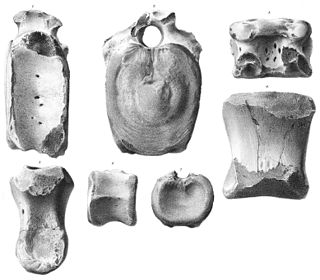
Thespesius is a dubious genus of hadrosaurid dinosaur from the late Maastrichtian-age Upper Cretaceous Lance Formation of South Dakota.

Diplotomodon is a dubious genus of theropod dinosaur, from New Jersey. It was possibly a member of the Tyrannosauroidea, the clade that also contains Tyrannosaurus.

Pneumatoarthrus is an extinct genus of sea turtle known from the Late Cretaceous Mount Laurel Formation of Monmouth County, New Jersey. Only a single species, P. peloreus, is known.

Muraenosaurus is an extinct genus of cryptoclidid plesiosaur reptile from the Oxford Clay of Southern England. The genus was given its name due to the eel-like appearance of the long neck and small head. Muraenosaurus grew to lengths between 5 metres (16 ft) and 6 metres (20 ft) and dates roughly to between 160 Ma and 164 Ma in the Callovian of the middle Jurassic. Charles E. Leeds collected the first Muraenosaurus which was then described by H. G. Seeley. The specimen may have suffered some damage due to the casual style of Charles Leeds’ collection. The first Muraenosaur was recovered with pieces missing from the skull and many of the caudal vertebrae absent. Because the animal was described from Charles Leeds’ collection it was given the name Muraenosaurus Leedsi. M. leedsi is the most complete specimen belonging to the genus Muraenosaurus and also the only species that is undoubtedly a member of the genus.. Two other species have been tentatively referred to as members of the genus Muraenosaurus: M. reedii and Picrocleidus beloclis

Hydrotherosaurus is an extinct genus of elasmosaurid plesiosaur from the Upper Cretaceous Moreno Formation of Fresno County, California, USA. The only known species, H. alexandrae, was named for its discoverer, Annie Montague Alexander, by Samuel Paul Welles.
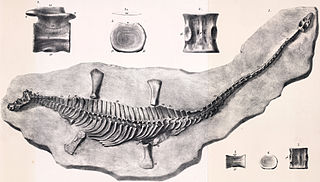
Microcleidus is an extinct genus of sauropterygian reptile belonging to the Plesiosauroidea. It was about the size of a medium-sized dolphin, reaching a length of 3 metres (9.8 ft). The species has 40 neck vertebrae and a short tail of 28 vertebrae. Fossils of the genus have been found in France, the Posidonia Shale in Germany and the Alum Shale Formation of England.
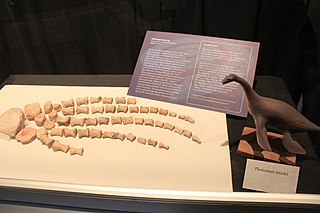
Woolungasaurus is a plesiosaur, an extinct marine reptile, belonging to the Elasmosauridae.
Morturneria is an extinct genus of plesiosaur from the Late Cretaceous of what is now Antarctica.
Ogmodirus is an extinct genus of plesiosaur found in the Cenomanian-Turonian Greenhorn Limestone of Kansas. It may be member of the Elasmosauridae, a group of marine animals related to Elasmosaurus, but the condition of the fossils discovered to date means the genus is dubious beyond Plesiosauria. The type species, O. martini, was named by Samuel Wendell Williston and Roy L. Moodie in 1913. The original specimen consisted of a pelvic girdle, limb elements, and more than fifty cervical (neck) vertebrae discovered in Cloud County, Kansas. A second species, Ogmodirus ischiadicus, has since been referred to Styxosaurus. Sepkoski (2002) assigned Ogmodirus to the Plesiosauria.
Bathyspondylus is an extinct genus of plesiosaur from the Kimmeridge Clay Formation of Swindon, England. Because it is known only from its fossil vertebrae, paleontologists are not entirely sure of the taxonomy of Bathyspondylus; the family it belongs to is not currently known. The type, and only known, species is B. swindoniensis, which was described from the same material as its genus.
Pantosaurus is an extinct genus of plesiosaur from the Late Jurassic (Oxfordian) of what is now Wyoming. It lived in what used to be the Sundance Sea. It was originally named Parasaurus by Othniel Charles Marsh in reference to Plesiosaurus, but that name was preoccupied, and Marsh changed it. The species Muraenosaurus reedii is in fact a junior synonym of Pantosaurus. The holotype YPM 543 is a partial articulated skeleton, partially prepared to yield a distal humerus, four articulated carpals, a fragment of the coracoid, and several isolated cervical vertebrae from the Upper Member of the Sundance Formation. Other material includes USNM 536963, USNM 536965, UW 3, UW 5544 and UW 15938.

Eretmosaurus is an extinct genus of plesiosaur.
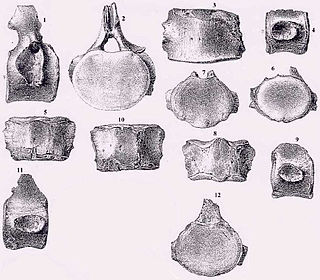
Discosaurus is an extinct genus of Cretaceous plesiosaur first discovered in Alabama by Joseph Leidy. It was argued to be the same animal as Elasmosaurus.

Sthenarosaurus is an extinct genus of rhomaleosaurid pliosauroid discovered in the Toarcian-aged 'Main Alum Shale' in Whitby, England. The type species, S. dawkinsi, was named and described in 1909. The type specimen is MMUM LL 8023, a set of postcrania discovered in Whitby. Other indetermiante specimens are known, including a pectoral girdle described in 1911.

Saniwa is an extinct genus of varanid lizard that lived about 48 million years ago during the Eocene epoch. It is known from well-preserved fossils found in the Bridger and Green River Formations of Wyoming, and evidence indicates Saniwa also lived in Europe. The type species S. ensidens was described in 1870 as the first fossil lizard known from North America. Several other species have since been added, but their validity is uncertain. It is a close relative of Varanus, the genus that includes monitor lizards.

Stratesaurus is an extinct genus of small-bodied rhomaleosaurid plesiosaur known from the Early Jurassic period of the United Kingdom. It contains a single species, S. taylori.
Jucha is an extinct genus of plesiosaur found in the Hauterivian Klimovka Formation of Russia. The type species, J. squalea, was one of the basalmost and oldest definitive elasmosaurs known to date.
References
- Leidy, J. (1854). "Remarks on exhibiting to the Society four vertebrae of a huge extinct Saurian from Arkansas" Proceedings of the Acadademy of Natural Sciences of Philadelphia, 7(3): 72.